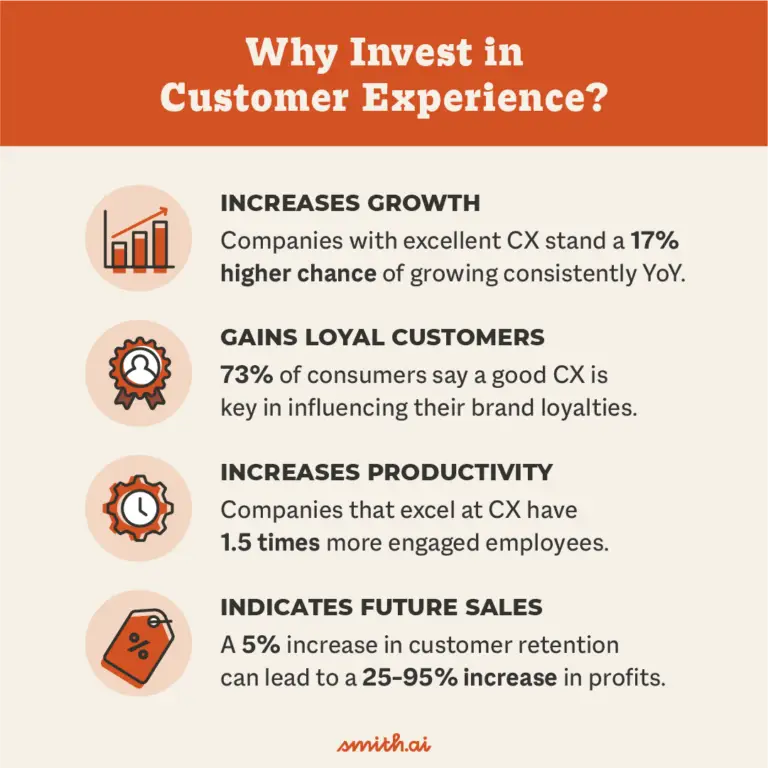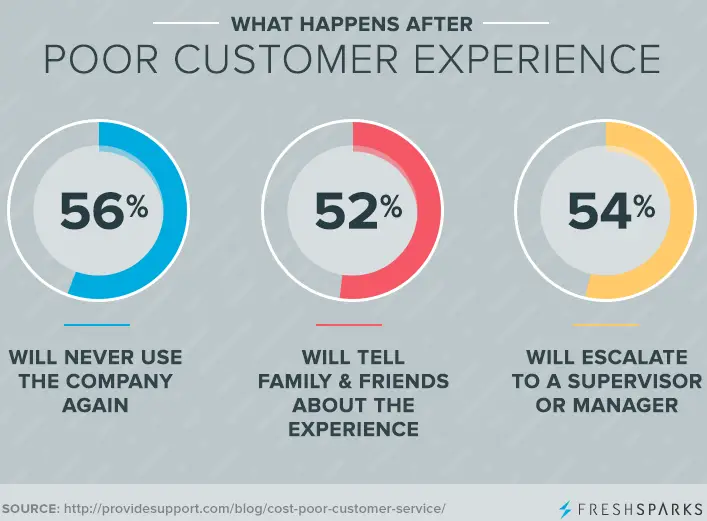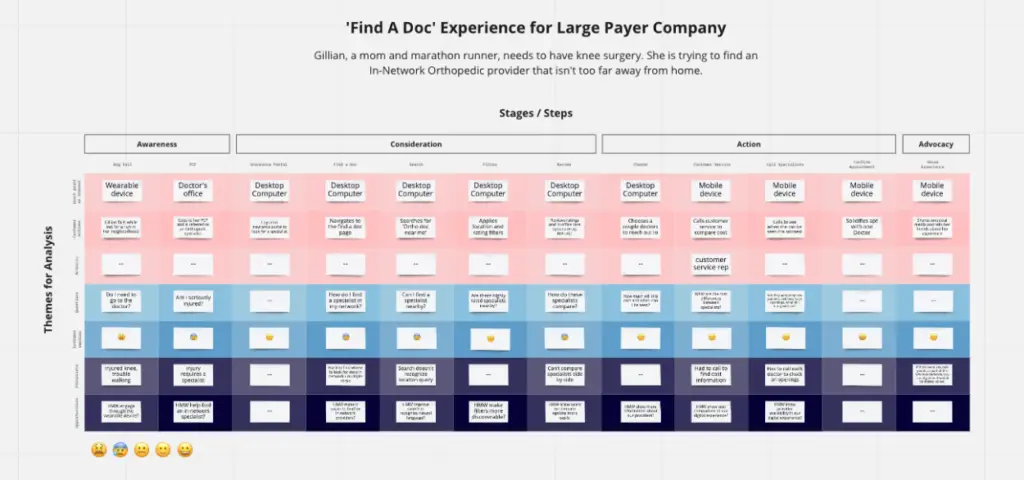Introduction
Customer experience is one of the most crucial things to invest in because it has a direct impact on your business’s success. According to a survey by Fullstory, 84% of respondents believe that the user experience provided by the business is equally important as the product or service.
Here are some of the reasons why you should pay close attention and invest in customer experience:

Customers expect connected journeys from businesses, and 76% of customers expect consistent interactions across departments as noted in a recent Salesforce Research survey. If you don’t provide a consistent customer experience up to industry standards, you will be at risk of losing your clients and damaging your overall brand. According to research by CX Service 360, 89% of customers switched to a competitor after a bad customer experience.

We will make sure that you don’t end up in that situation by helping your business to provide the best customer experience possible. In this guide on how to make a customer journey map, we will talk about one of the most effective tools that will help you understand your customers and adjust your business processes according to their needs.
What is customer journey mapping?
Customer journey mapping is a user experience research exercise that allows you to obtain a holistic end-to-end view of your customers actions and emotions as they try to reach a goal within your digital experience. Documenting your users’ experience into a visual map enables you to uncover gaps and opportunities that will help you design a truly great customer experience and create more internal alignment in the process.
Journey mapping can be used:
- To identify gaps and opportunities in your existing user experience
- To explore an ideal future state experience
- To evaluate and improve internal workflows and communication within your organization
- To align your team around a common goal and increase cross-discipline collaboration
- To improve customer journeys and marketing efforts
In each of the above mentioned scenarios, journey mapping will allow you to obtain an understanding of:
- Each individual touchpoint within a product, system, or experience
- Roles and responsibilities of each touchpoint, to determine how it should be managed
- Interdependencies of how touchpoints relate to each other
- What is working and not working at each individual touchpoint
- The root of potential problems that might be prevented
Why customer journey mapping can be beneficial for your business?
A holistic view of potential problems and their causes
You may already be aware that a problem exists on a certain page or screen, however, with journey mapping, you will be able to see the bigger picture and find the root cause.
For example, if you see that you have a low conversion on your page, your first move may be to make changes to the CTA or other design elements. However, by mapping the customer experience, you might discover that the user simply does not have enough information to make the desired action. In this scenario, adding additional information to some of the previous touchpoints could improve the conversion rate.
Additionally, with journey mapping, we are not talking about just a single user flow, but about all possible user flows. You will be able to catalog multiple user journeys and determine whether they are optimal, how they overlap and how they align with your business goals.
Align around a common goal
After you identify the problems in your customer experience, you will be able to brainstorm as a team and align around a common goal. As you build and review your map, we recommend including stakeholders from different areas of your business that will help to provide a 360˚ view of your user.
To start, gather a team of 5-8 people from customer service, customer experience, marketing, analytics, product and design. Not only will this increase cross-discipline collaboration, but it can help to push initiatives along when everyone is on the same page. Plan carefully how you will fix sub-issues at every touchpoint iteratively, to achieve greater results.
Put executives on the same page
If you have a large organization, your main decision-makers may not be aware of some important details of the specific touchpoints of their product. While executives must see the bigger picture, they also should be well-informed to make the right decisions.
A collaborative journey-mapping exercise can get executives on the same page with your technology and design teams and enable broad consensus with decisions based on a complete understanding from all parties.
Leverage smart prioritization
Here, at UpTop we don’t stop when the map is complete, but rather work on possible customer journey solutions to help our clients prioritize issues and plan the next steps.
Our actions include:
- After mapping each area of friction or issue with a KPI, we analyze the results. If solving a specific problem won’t change KPIs in a positive direction, it shouldn’t be a priority
- Impact vs effort exercises that are aimed at finding the most effective solutions with minimal effort
- Connecting current pain points to the emotional response of users, helping identify the areas with the most negative user responses, which should be covered first
“We see our customers as invited guests to a party, and we are the hosts. It’s our job every day to make every important aspect of the customer experience a little bit better.”
— Jeff Bezos, an American entrepreneur, media proprietor, investor, computer engineer, and commercial astronaut
How to make a customer journey map: key elements
Now, as we covered the definitions and benefits, let’s move on to tips on how to build a customer journey map. We will start with brief descriptions of the key elements.
Stages
Start your map by identifying the stages of the customer journey. The four essential stages include:
- Awareness
- Consideration
- Purchase
- Installation
While the stages may have different names, the essence stays the same. Sometimes a stage called loyalty or advocacy is added at the end.
User personas
Before creating your map, you’ll need to determine who the map is for. That’s where user personas come in. A user persona is a composite representation of a certain market segment, and will be the main actor in your journey map. Creating personas of your core user groups helps you better understand their behaviors, motivations and pain points, and for CX teams, it is much easier to predict the motivation of customers if they are split into multiple personas. When building out your journey map you’ll want to focus on one persona and one scenario per map to create a more focused narrative.
Journey mapping steps
Once you know the scenario you want to map out, identify each key moment or touch point that the user has within their journey as they engage with your company over time and across channels. The steps will make up the horizontal axis of your map and could be a user interacting with an advertisement in the awareness phase, conducting research in the consideration phase and communicating with a customer service representative in the installation phase.
Themes for analysis
The themes for analysis will make up the vertical axis of your map and are generally composed of the touchpoint or channel, customer actions, actors, questions, customer emotions and pain points. Trying to predict the emotions and feelings of customers is one of the main goals of every customer journey map. If you realize that you fail to draw conclusions on how your customers feel while creating your customer journey map, more qualitative research may be needed to better understand the why of their behavior and how they feel at each touchpoint.
How to build a customer journey map right: Best practices
Before discussing the actual customer journey mapping stages, here are some tips and best practices that are useful during the development of your map.
Focus on your customer
Your journey map should focus on how your customer experiences the interaction with your company. In order to obtain that vision, you should leverage user interviews, stakeholder and Subject Matter Expert (SME) interviews, analytics review, persona definition, surveys, and task flow analysis. If you feel like your own research is not enough, you can always hire more experienced professionals for proper customer journey mapping consulting services.
Keep different customer segments in mind
You should always be aware that different customer segments experience the same product or service differently. That’s why it is important to label customer segments accurately in your map and for you to invest in multiple customer personas.
Make sure that maps connect all touchpoints
Those touchpoints include interactions via email, websites, texts, social media platforms, chats, etc. Your map should reflect the different sequences in which customers make their journey through the touchpoints.
Useful tools for mapping customer experience
For the last few years, we, at UpTop, use mostly:
- Miro, a service that offers a digital whiteboard for real time collaboration and convenient templates for customer journey maps
- UXPressia, a tool that allows you to develop designer-quality customer journey maps quickly
However, there are plenty of other tools that will allow you to map and visualize all stages of the customer journey. Other honorable mentions include Journey Builder from Salesforce, Smaply, and Canvanizer.
What data can you leverage?
Solicited data
This is data you get from customers directly, such as through surveys, analytics, and customer support feedback/logs. Solicited data is critical for obtaining an understanding of the customers’ points of view. Keep in mind that surveys most likely will get you insights on a particular moment or a touchpoint. Additionally, the answers that your customers will provide might not reflect their sentiments and intentions. So, with this type of data, you will get only part of the picture. To fill in the gaps one-on-one customer interviews or moderated usability studies can help you to identify what your users think about your digital experience and uncover the why behind their actions.
Unsolicited data
This type of data is all about what your customers aren’t telling you directly such as contextual data like purchase history. You can get this information through your website and social media channels, various third-party websites, frontline employee feedback, etc.
By triangulating solicited data and unsolicited data, you will get the fullest possible picture of the customer journey. You can always collaborate with internal stakeholders in order to validate areas that might appear inaccurate.
How to make a customer journey map: Step-by-step guide
Developing customer personas
Start by creating customer personas to determine whose journey will be mapped and what goals they are trying to accomplish during the experience. Your personas should be specific and reflect particular needs, goals, feelings, and expectations of users, while at the same time highlighting any pain points of using a product or service. It can be helpful to create quotes for each persona that capture their personal stories, values and goals.
Here are the key parameters that your persona should include:
- Name
- Demographics
- Personal Story
- Goals and Motivations
- Behaviors and Beliefs
Map out the steps
Brainstorm with your team all the essential touchpoints or steps of the end-to-end customer journey, labeling them in one or two words and recording them on post-it notes. When the brainstorming session is complete, place the post-it notes in an order you think the user would likely experience them from left to right on the horizontal axis. You can group particular steps into the stages we mentioned above: from awareness to advocacy.
Come up with themes to analyze
If you want to get the most value out of your map, choose multiple themes to analyze. While determining touchpoints and knowing user actions are very important, the following themes will help you understand user experience more deeply:
| Touchpoint or Channel | Where and how users engage with a product or service |
| Customer Actions | The action users take to move to the next step in the flow |
| Actors | People that engage with users during the journey |
| Questions | The questions users need answered before they can move to the next step |
| Customer Emotions | Emotions users experience at each touchpoint |
| Pain Points | Points of frustration or annoyance for users during their journey |
| Opportunities | Design improvements that might fix problems in your user journey or help you stand out from the competition |
Fill in your journey map
Put your journey mapping steps on the top of the grid horizontally, and the themes for analysis on the left column vertically. This will be the base of your map.
Collectively, with your team, fill in what the user is doing at each step, any actors they might encounter, what questions they might have, and what emotions and paint points they experience along the way.
To get the best results, fill the grid from left to right and from the top to bottom. Regularly reference your persona as a source of inspiration and save the row with opportunities for last.
Find the areas of opportunity
Once every other category is filled, an experienced team will be able to see areas for growth and brainstorm solutions suitable for your specific situation. Of course context matters; if you are doing customer journey mapping for financial services, the possible solutions will differ from maps that reflect the customer journey for restaurants, so it is important to have people on your team with expertise in that specific industry.
Here is an example of a completed customer journey map for the Healthcare industry:

The most common mistakes you can make
Not involving all critical departments
Make sure that you have input from the critical departments of your organization, especially those who are working with customers directly, while you are creating a map. When the map is created, it is important to share it with your customer experience, marketing, and sales teams to improve their efforts or to let them know what is working well.
Not enough data
Collect as much data as possible. Both solicited, and unsolicited data are important to have a holistic vision of CX in your organization.
Treating your map as static
Finally, treat your maps as living and breathing entities that you should update periodically, as your organization evolves. Your customer journey map should be visible to all teams that influence the customer experience directly, and it should be maintained according to internal and external changes in business and market forces.
Our expertise
Here, at UpTop we’ve provided customer journey mapping services since 2000 and approximately 30% of our clients have used this service.
In most cases, clients need customer journey mapping for specific help detailing their buyer journeys, so they can provide the most optimal CX to their customers. Among our clients are a mid-size technology services company, a mid-size health insurance company, a mid-size stop loss and underwriting company, and a small consumer clothing business that is experiencing exponential growth.
In one of our projects, which is under NDA, our journey mapping services helped a mid-size stop loss insurance company identify gaps in their internal underwriting process. The resulting map detailed a complex workflow that incorporated multiple users and approximately 70+ steps or touchpoints. The impact of the visual map provided the team with documentation of their process and gave management a more empathetic view of the users, challenges and the required effort to solve them.
Conclusion
Crafting a competent customer journey map is only the beginning. A carefully created map will unlock new opportunities for your organization to improve your overall customer experience and help you differentiate from your competitors. Make sure to involve key stakeholders from different areas of your business in the journey mapping process and constantly update your map as you make improvements.
If you don’t have enough experience, contact a ux agency to learn more about Journey Mapping and how it can help your organization. We’re happy to help you get started.
FAQ
How to create a customer journey map?
To create a map, you should go through the following stages: developing customer personas, mapping out the steps, coming up with themes to analyze, filling your journey map, and finding the areas of opportunity.
What tools are used for building a customer journey map?
Start with online tools like Miro, Figma, UXPressia, Journey Builder from Salesforce, Smaply, and Canvanizer.
What are the components of a customer journey map?
Every map should include user personas, touchpoints, customer actions, customer emotions, and pain points.
Why is customer journey mapping important?
It is important because it allows your company to have a holistic view of existing problems, puts executives on the same page, and develops and prioritizes possible solutions.


